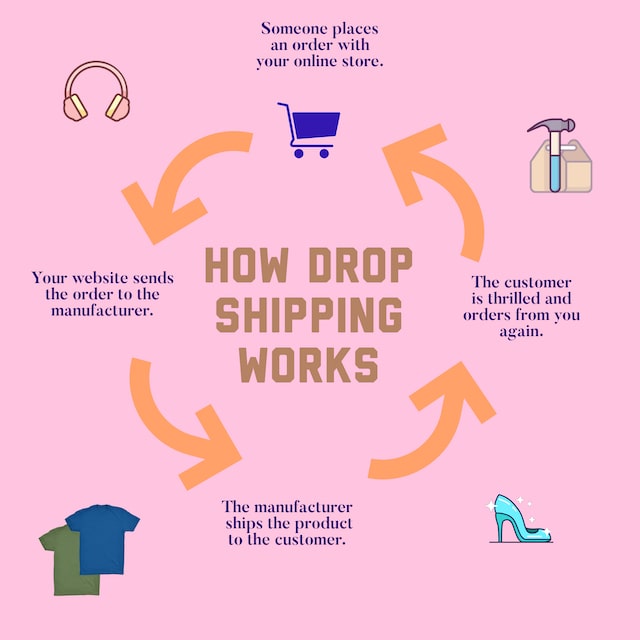The pandemic-induced ecommerce boom has put a spotlight on drop shipping. The questions are endless. What is drop shipping? How does it work? Is drop shipping a get rich quick scheme for scammers?
What is drop shipping?
At its core, drop shipping is an order fulfillment method.
This method is used by businesses and entrepreneurs who purchase products on an as-needed basis from a third party.
In this case, the third party is usually a wholesaler or a manufacturer.
The business the customer is buying from doesn’t actually have the item in stock. They don’t have a warehouse or boxes or packing tape. All they have is an online store and probably a few marketing skills.
Only when ordered does the item get put in a box and sent to the customer (fulfilled). The drop shipper simply facilitates the sale. They are in the middle, between the customer and the wholesaler/manufacturer.

What is a drop shipper?
A drop shipper can be a person or a business. They purchase inventory and fulfillment logistics (shipping) from a third-party.
Is drop shipping legal in Canada?
Yes, drop shipping is legal in Canada. Many small and large retailers use this fulfillment model. To ensure your business runs above board, consult a lawyer in your region.
How does drop shipping work?
There are a few ways you can go about drop shipping.
Approach #1
Find a supplier based in North America or beyond by using supplier databases.
Here are a few websites to help you locate a supplier:
Approach #2 
Connect your online store to countless suppliers via an app.
One such app to consider is DSers. It’s a Shopify app that also allows you to browse AliExpress and import the products directly to DSers.
The pros and cons of drop shipping
Budding entrepreneurs turn to drop shipping because it’s an accessible business model and a $15 billion industry. If you’re thinking about becoming a drop shipper, take note of the following pros and cons.
The Pros
Low cost and less risk
- You don’t need to have a war chest of money to launch an ecommerce store. With a traditional online store, where you would have product in-house, there’s a hearty upfront inventory cost to consider. Drop shipping eliminates that.
Work from home
- You can operate your store from your laptop, which means you can work from home. Or if you’re an adventure seeker, you could become a digital nomad and work while you travel.
Give your customers what they want when they want it
- You know your company’s demographic and what new products they’d be interested in purchasing. With drop shipping, your products will never go stale.
Related: How to identify your target market
Product testing and business growth made easy
- When you don’t have in-house inventory, you can try out new products with lessJust stop promoting any product that doesn’t
 sell well.
sell well. - For traditional online sellers, more sales come with production problems. With drop shipping, you can grow slowly and increase your customer support to minimise risk (and turn first-time shoppers into repeat customers).
The Cons
Competition is everywhere
- You may find that other drop shipping companies will list similar products far below your asking price. Offer what they can’t — such as better customer service or a stylish and user-friendly website. Remove the barriers to trial before you start slashing your prices. Focus on building trust.
Related: Customer service skills that will bring them back for more
Hiccups in the supply chain
- When you outsource your products and don’t have them on-hand, it’s difficult to guarantee the quality. More so when there are kinks in the supply chain and unforeseen shortages.
- These hiccups also impact shipping, which can be quite complex.
Less than perfect products
- When we fall in love with a product and move forward with a supplier, we hope that others will fall in love with it too. But sometimes, suppliers make errors. Sometimes, the product quality shifts, and the new material used may not meet your standards. One thing is certain. If your customers have a less than favourable experience, they will tell the world about it.
Now that we’ve explained what drop shipping is and both its benefits and drawbacks, let’s travel back in time for a slice of drop shipping history.
Drop shipping, before it was cool
There once was a time when Canadians would get excited to receive the Sears catalogue in the mail. You name it, the catalogue had it: major appliances, toys, homes, and more!
Some would place orders immediately, often within the same day. Others would slowly thumb through the pages, deeply contemplating each product before making an order.
What does this have to do with drop shipping?
Well, contrary to popular belief, drop shipping predates ecommerce.
It has been around since the 60s. Back then it was used by catalogue companies taking orders by phone or mail.
It was quite pricy to do drop shipping, and as a result, it wasn’t widely used by locally owned small businesses. They were committed to having their shelves stocked with products that were ready to walk out the door.
The next time someone tells you that drop shipping is a new trend or worse, a contemporary scam, throw those facts their way. Tell them that drop shipping has evolved and ecommerce is what enabled it to live its best life.
Drop shipping explained

There is more than one way to start a business. As you weigh your options, don’t overlook drop shipping just because you’ve heard it’s a scam. The startup costs are low, and your success is limited only by how good you are at:
- Finding reliable partners
- Promoting the products you choose
For anyone who likes to be their own boss, it’s a business model worth considering.
Got a great name for your drop shipping business? See if the domain name is available now:
________________________________
Frequently Asked Questions FAQs
How do I identify a drop shipping scam?
The internet is ripe with scams and drop shipping is not immune. Knowledge is power. Here are a few ways you can identify possible scams.
- Fake reviews. If the reviews look like they were created by a bot and if some of the reviewers look as if they’ve been paid to praise the company, steer clear.
- Fake manufacturers. Do a little extra digging on the manufactures to ensure that they exist.
- Check out the company contact info. You should be able to contact the business owner.
- Dodgy details. The website mentions additional parties (distributors, and so on) and adds on additional fees that seem illogical.
How do I start a drop shipping business?
- Ideate and choose a sector for your drop shipping business.
- Research your competition and find your niche.
- Review drop shipping suppliers and start relationship building with preferred manufacturers.
- Create your business plan, organize your finances, and work with a graphic designer on your brand.
- Create marketing materials and an ad rollout calendar before you launch your ecommerce store.
- After launch, analyze your results and refine and improve your offerings.





